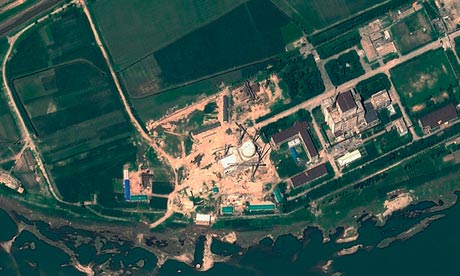North Korea suspected of restarting Yongbyon nuclear reactor
Satellite imagery shows reactor capable of producing plutonium for weapons is likely to be operating, says US research institute
 North Korea's Yongbyon nuclear complex seen in a satellite image taken last year. Photograph: Geoeye Satellite Image/AFP/Getty Images
North Korea's Yongbyon nuclear complex seen in a satellite image taken last year. Photograph: Geoeye Satellite Image/AFP/Getty ImagesNorth Korea appears to have restarted a reactor capable of producing weapons-grade plutonium, according to analysis of satellite imagery and a US official.
White steam can be seen rising from a building near the hall housing steam turbines and electric generators at Yongbyon nuclear complex in an image taken on 31 August, said the US-Korea Institute at Johns Hopkins School of Advanced International Studies.
Pyongyang announced it would restart the reactor this spring, amid high tensions on the peninsula. Relations have since improved, with North and South Korea saying on Wednesday that their joint industrial complex at Kaesong, closed in April, would reopen on a trial basis on Monday.
The US-Korea Institute said the gas-graphite reactor was capable of producing 6kg of weapons-grade plutonium a year. It believes that the North already has 34-36kg, sufficient for around a dozen weapons.
"The white coloration and volume are consistent with steam being vented because the electrical generating system is about to come online, indicating that the reactor is in or nearing operation," wrote Nick Hansen and Jeffrey Lewis on 38 North, the website of the Washington-based institute.
Previous images had shown that the North was repairing the reactor, which wasmothballed in 2007 as part of a six-party aid-for-denuclearisation deal that subsequently broke down.
A US official speaking on condition of anonymity told Reuters that he believed the North Koreans had restarted the reactor, saying that the amount of steam suggested it was being tested.
The official suggested Pyongyang was showing it would not abandon its nuclear programmes, rather than trying to force major powers to resume nuclear talks so that it could extract concessions.
He said the North "wants to create a fait accompli and be accepted as a [nuclear] power and nuclear weapons state." The only way to counter it would be to "raise the cost to them of taking this path, and increasing multilateral pressure, with China an active participant".
Andre Lankov, of Kookmin University in Seoul, said: "If the US behaves as if North Korea does not exist, they will become even more of a problem. Neglect, also known as strategic patience, is not, on balance, a bad approach, but cannot be sustained for a long time.
"The North Koreans won't just sit and beg or enjoy visits from eccentric basketball players. They are going to develop their nuclear capabilities."
Pyongyang announced in April that it would reopen the nuclear complex, which also includes a uranium enrichment facility. Experts had predicted it would take up to six months to restore operations at the reactor.
Although the North destroyed the Yongbyon cooling tower in 2008 as a confidence-building step, the US-Korea Institute had already said that it would not need to reconstruct the tower and could instead connect the reactor to a new pump-house.
Repeated attempts to use carrot and stick to halt the North's nuclear programme have faltered. While some have called for a return to multinational negotiations, Glyn Davies, the US special representative for the North, said on Monday that it was "very hard to imagine how the six-party [talks] could be fruitful at the moment".
No comments:
Post a Comment